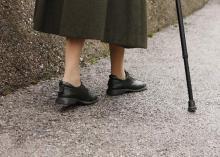Gait speed was independently associated with hospitalization and death and aided in risk stratification of elderly patients with heart failure in a study reported online March 9 in JACC Heart Failure.
Optimal clinical management of heart failure is dependent on accurate prognostic stratification, Dr. Giovanni Pulignano and his coinvestigators wrote. Geriatric conditions such as frailty, cognitive impairment, and disability impact prognosis along with comorbidities and cardiac disease. Further, gait speed is a marker of frailty and is predictive of adverse health events in older patients, including mortality. However, there is limited research on the impact of geriatric conditions in heart failure studies.
Dr. Pulignano of San Camillo Hospital in Rome and colleagues sought to examine the relationship between gait speed in older patients with heart failure and the risk of hospitalization and death.
The investigators calculated the predicted all-cause mortality using the Cardiac and Comorbid Conditions Heart Failure (3C-HF) score. Variables included in the 3C-HF score are left ventricular ejection fraction of less than 20%, New York Heart Association class III-IV heart failure, no renin-angiotensin inhibitor treatment, no beta-blocker treatment, severe valvular heart disease, diabetes with macro- or microangiopathy, atrial fibrillation, hypertension, anemia, renal dysfunction, and older age.
Participants were at least 70 years old, with clinically stable heart failure with normal or reduced left ventricular ejection fraction and a previous hospitalization necessitating intravenous inotropes, diuretics, and/or vasodilators for heart failure.
Exclusion criteria included a condition that would decrease their walking speed, valvular heart disease with surgery planned, long-term intravenous inotrope treatment, or living in a nursing home.
Gait speed was assessed over 4 meters and grouped into groups of slow walkers (up to 0.65 m/s), intermediate walkers (0.66-0.99 m/s), and fast walkers (at least 1.0 m/s). Participants were allowed to use a walker or cane as a walking aid.
Data were analyzed on 331 patients (mean age 78 years, 43% women) with clinically stable and optimized chronic heart failure (mean NYHA class 2.7, mean left ventricular ejection fraction 35%). The mean 3C-HF score was 19.7 points.
The mean gait speed was 0.74 m/s, with 35% (115 patients) demonstrating severely reduced (less than or equal to 0.65 m/s) gait speed.
After 1 year of follow-up, they found a significant association between the measured gait speed and 1-year mortality, with 9.1%, 21.9%, and 38.3% for the high, intermediate, and low tertiles, respectively (P less than .001). A similar relationship was found for gait speed and heart failure–related hospitalization (26.6%, 58.6%, and 71.3%, respectively; P = .002) and all-cause hospitalization (26.6%, 58.6%, and 71.3%, respectively; P = .002).
Multivariate analysis revealed an independent association between gait speed and lower risk of all-cause death (hazard ratio, 0.62; P = .008). Gait speed was also associated with a lower risk for all-cause hospitalizations (HR, 0.74; P = .002) and heart failure–related hospitalizations (HR, 0.69; P = .004).
Finally, when gait speed was included in the 3C-HF risk score, accuracy of risk stratification for all-cause death (net reclassification improvement, 0.49; P less than .001) and heart failure admissions (NRI, 0.37; P less than .001) was improved (JCHF. 2016 Mar 9. doi:10.1016/j.jchf.2015.12.017).
“Gait speed, in combination with a validated clinical risk score, improves prognosis prediction in older HF patients,” the investigators concluded. “Frailty assessment using gait speed is simple and inexpensive and suggests new strategies for intervention. Its measurement should be incorporated in the routine clinical evaluation of older patients with HF.”
The study was supported by the ADRIANO-Italian Association for Research on Cardiac Disease in Older Patients. The authors had no disclosures.


